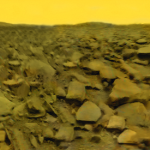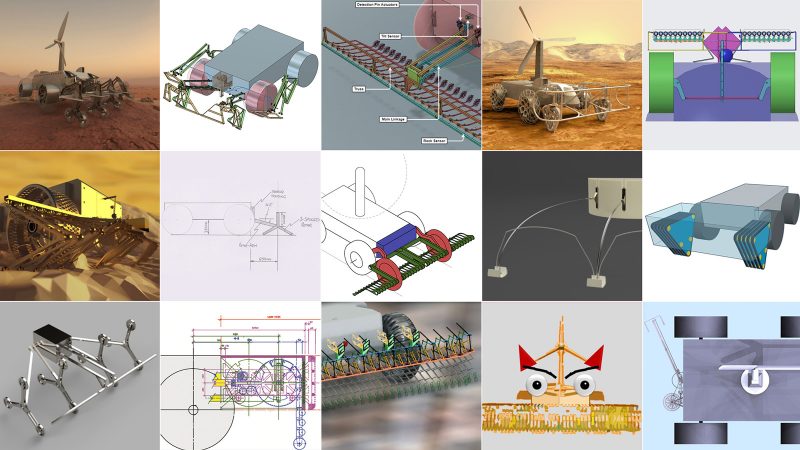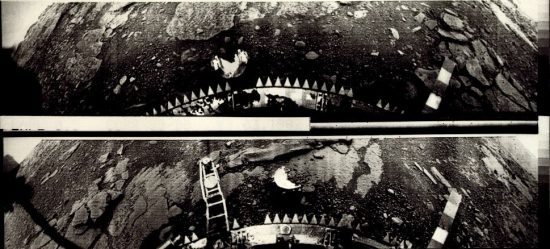

View larger. | This collage shows all 15 finalists for NASA’s “Exploring Hell” Venus rover competition. In all, designers, makers, and citizen scientists in 82 countries submitted 572 entries. Image via NASA/ HeroX.
Published originally by NASA’s Jet Propulsion Laboratory on July 6, 2020
How do you design a vehicle that can withstand the furnace-like heat and crushing pressures of Venus? One idea being explored by NASA’s Jet Propulsion Laboratory in Southern California is a wind-powered clockwork rover, and it’s just been given a boost by designers, the maker community, and citizen scientists from around the world. In February, NASA launched a public competition to seek ideas for a mechanical obstacle-avoidance sensor that could be incorporated into the novel rover’s design. And on July 6, 2020, the winners were announced.
Jonathan Sauder, a senior mechatronics engineer at JPL, said:
The response from the community was incredible and better than I ever dreamed. There were so many great ideas and well-developed concepts that in addition to first, second, and third place, we decided to add two finalists and another 10 honorable mentions in recognition of the amazing work people put into this project.
The brilliance of the ideas is matched by the harrowing challenge facing future robotic explorers of Venus. The longest any spacecraft has survived on the surface of Venus is a little over two hours – a record set by the Soviet Union’s Venera 13 probe in 1981. And the last spacecraft to land on Venus was the Soviet Vega 2 mission in 1985. It survived only 52 minutes.
Venus may be known as Earth’s “sister planet,” but to develop machines that can better withstand its harsh environment, we’ll obviously need a different approach.

Surface of Venus from the Soviet Venera 13 lander, March 1, 1982. The lander set a record by surviving just over 2 hours on the hellish surface of Venus. See more images from Venus’ surface in this blog post by Ted Stryk, via the Planetary Society.
Enter AREE, a project being led by Sauder at JPL. Short for Automaton Rover for Extreme Environments, AREE is a rover concept with a mechanical locomotion approach capable of performing complex sequences of operations and instructions autonomously. The concept originated as a NASA Innovative Advanced Concepts (NIAC) study, which funds early-stage technologies that may support future space missions.
AREE would use a small wind turbine and a system of springs to generate and store mechanical energy that could power its locomotion. Think of how a wind-up pocket watch stores energy and drives the motion of its internal gears to keep the time, and you have a basic idea about how this machine would operate.
By replacing sensitive electronics and delicate computers with gears, components made from advanced heat-resistant alloys, and limited-capability high-temperature electronics, a more robust machine can be built – one that might last for months in the punishing environment.
But how would such a machine navigate the terrain without advanced electronic sensors? That was the question behind NASA’s Exploring Hell: Avoiding Obstacles on a Clockwork Rover challenge. In all, 572 entries from a mix of teams and individuals were submitted from 82 countries, with ideas that ranged from systems of rollers to detect hazards to oversized fenders that would snap the rover in reverse should it hit a boulder.
The first-place prize is $15,000; second place wins $10,000; and third place, $5,000. The two additional, unplanned finalist prizes for the entry that was the most innovative and the entry with the best prototype are $2,000 each. The grant money was provided by NIAC and NASA Prizes and Challenges programs.
But the biggest prize for the finalists? Being considered for inclusion in AREE’s design as the rover concept continues to develop.
Final Awards
First Place: “Venus Feelers” by Youssef Ghali
Second Place: “Skid n’ Bump – All-mechanical, Mostly Passive” by Team Rovetronics
Third Place: “Direction Biased Obstacle Sensor (DBOS)” by Callum Heron
Best Prototype: “AMII Sensor” by KOB ART
Most Innovative: “ECHOS: Evaluate Cliffs Holes Objects & Slopes” by Matthew Reynolds
Honorable Mentions
“CATS – Cable Actuated Tactile Sensor” by Team – Spaceship EAC
“Mechanical Logic Obstacle Avoidance Sensor” by Christopher Wakefield
“Clockwork Cucaracha” by Michael Sandstrom
“Vibrissae Inspired Mechanical Avoidance Sensor” by ARChaic Team
“V-Track with Scotch Yoke Clinometer – Prototype” by Jason McCallister
“SPIDER (Sense, Perceive, ID in Exploration Rover)” by Ryan Zacheree Lewis
“The Double Octopus” by Thomas Schmidt
“Mechanical Sensor for Avoiding Compound Obstacles” by Aurelian Zapciu
“DEMoN Fire Sensor” by Santiago Forcada Pardo
“Cane and Able” by Martin Holmes
For more information about the challenge and the winning entries, including videos and photos of the designs, visit:
https://www.herox.com/VenusRover/128-meet-the-winners
You can also participate in a moderated discussion with Jonathan Sauder and the winners of the “Exploring Hell” Challenge, hosted by HeroX, on July 23 at 10 a.m. PDT (1 p.m. EDT). Register here.
Learn more about opportunities to participate in your space program:

This modified image is based on the 1st-ever image from the surface of Venus – 1st-ever from another planet, in fact – returned by the Soviet Venera 9 spacecraft in 1975. Looks harsh, doesn’t it? Image via Venera 9/ Ted Styrk. Read more about this image from the Planetary Society.
Bottom line: The Venus rover challenge – titled “Exploring Hell” – received a great response from countries around the world. The design ideas submitted will help advance the final design of a mechanical rover that might one day explore the hellish surface of Venus.
from EarthSky https://ift.tt/3fgTQa4


View larger. | This collage shows all 15 finalists for NASA’s “Exploring Hell” Venus rover competition. In all, designers, makers, and citizen scientists in 82 countries submitted 572 entries. Image via NASA/ HeroX.
Published originally by NASA’s Jet Propulsion Laboratory on July 6, 2020
How do you design a vehicle that can withstand the furnace-like heat and crushing pressures of Venus? One idea being explored by NASA’s Jet Propulsion Laboratory in Southern California is a wind-powered clockwork rover, and it’s just been given a boost by designers, the maker community, and citizen scientists from around the world. In February, NASA launched a public competition to seek ideas for a mechanical obstacle-avoidance sensor that could be incorporated into the novel rover’s design. And on July 6, 2020, the winners were announced.
Jonathan Sauder, a senior mechatronics engineer at JPL, said:
The response from the community was incredible and better than I ever dreamed. There were so many great ideas and well-developed concepts that in addition to first, second, and third place, we decided to add two finalists and another 10 honorable mentions in recognition of the amazing work people put into this project.
The brilliance of the ideas is matched by the harrowing challenge facing future robotic explorers of Venus. The longest any spacecraft has survived on the surface of Venus is a little over two hours – a record set by the Soviet Union’s Venera 13 probe in 1981. And the last spacecraft to land on Venus was the Soviet Vega 2 mission in 1985. It survived only 52 minutes.
Venus may be known as Earth’s “sister planet,” but to develop machines that can better withstand its harsh environment, we’ll obviously need a different approach.

Surface of Venus from the Soviet Venera 13 lander, March 1, 1982. The lander set a record by surviving just over 2 hours on the hellish surface of Venus. See more images from Venus’ surface in this blog post by Ted Stryk, via the Planetary Society.
Enter AREE, a project being led by Sauder at JPL. Short for Automaton Rover for Extreme Environments, AREE is a rover concept with a mechanical locomotion approach capable of performing complex sequences of operations and instructions autonomously. The concept originated as a NASA Innovative Advanced Concepts (NIAC) study, which funds early-stage technologies that may support future space missions.
AREE would use a small wind turbine and a system of springs to generate and store mechanical energy that could power its locomotion. Think of how a wind-up pocket watch stores energy and drives the motion of its internal gears to keep the time, and you have a basic idea about how this machine would operate.
By replacing sensitive electronics and delicate computers with gears, components made from advanced heat-resistant alloys, and limited-capability high-temperature electronics, a more robust machine can be built – one that might last for months in the punishing environment.
But how would such a machine navigate the terrain without advanced electronic sensors? That was the question behind NASA’s Exploring Hell: Avoiding Obstacles on a Clockwork Rover challenge. In all, 572 entries from a mix of teams and individuals were submitted from 82 countries, with ideas that ranged from systems of rollers to detect hazards to oversized fenders that would snap the rover in reverse should it hit a boulder.
The first-place prize is $15,000; second place wins $10,000; and third place, $5,000. The two additional, unplanned finalist prizes for the entry that was the most innovative and the entry with the best prototype are $2,000 each. The grant money was provided by NIAC and NASA Prizes and Challenges programs.
But the biggest prize for the finalists? Being considered for inclusion in AREE’s design as the rover concept continues to develop.
Final Awards
First Place: “Venus Feelers” by Youssef Ghali
Second Place: “Skid n’ Bump – All-mechanical, Mostly Passive” by Team Rovetronics
Third Place: “Direction Biased Obstacle Sensor (DBOS)” by Callum Heron
Best Prototype: “AMII Sensor” by KOB ART
Most Innovative: “ECHOS: Evaluate Cliffs Holes Objects & Slopes” by Matthew Reynolds
Honorable Mentions
“CATS – Cable Actuated Tactile Sensor” by Team – Spaceship EAC
“Mechanical Logic Obstacle Avoidance Sensor” by Christopher Wakefield
“Clockwork Cucaracha” by Michael Sandstrom
“Vibrissae Inspired Mechanical Avoidance Sensor” by ARChaic Team
“V-Track with Scotch Yoke Clinometer – Prototype” by Jason McCallister
“SPIDER (Sense, Perceive, ID in Exploration Rover)” by Ryan Zacheree Lewis
“The Double Octopus” by Thomas Schmidt
“Mechanical Sensor for Avoiding Compound Obstacles” by Aurelian Zapciu
“DEMoN Fire Sensor” by Santiago Forcada Pardo
“Cane and Able” by Martin Holmes
For more information about the challenge and the winning entries, including videos and photos of the designs, visit:
https://www.herox.com/VenusRover/128-meet-the-winners
You can also participate in a moderated discussion with Jonathan Sauder and the winners of the “Exploring Hell” Challenge, hosted by HeroX, on July 23 at 10 a.m. PDT (1 p.m. EDT). Register here.
Learn more about opportunities to participate in your space program:

This modified image is based on the 1st-ever image from the surface of Venus – 1st-ever from another planet, in fact – returned by the Soviet Venera 9 spacecraft in 1975. Looks harsh, doesn’t it? Image via Venera 9/ Ted Styrk. Read more about this image from the Planetary Society.
Bottom line: The Venus rover challenge – titled “Exploring Hell” – received a great response from countries around the world. The design ideas submitted will help advance the final design of a mechanical rover that might one day explore the hellish surface of Venus.
from EarthSky https://ift.tt/3fgTQa4

Aucun commentaire:
Enregistrer un commentaire